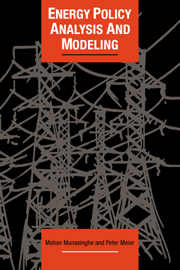Book contents
6 - Optimization models
Published online by Cambridge University Press: 05 March 2012
Summary
As noted earlier in chapter 3, the most fundamental task of energy analysis is to define alternative options – for energy pricing, for energy sector investments, and so on – and quantify their impacts on the objectives established for national energy planning. If, say, two policies are to be evaluated, there must also exist some explicit basis for comparing them, preferably on some ordinal scale of measurement. That is, we are interested not only in a ranking of alternatives, but in general one also wishes to know by exactly how much one alternative is better than another. This may well be an obvious point, yet it is particularly important where multiple objectives must be simultaneously evaluated: policy A may be better to policy option B in terms of, say, some cost-minimization objective, but worse when evaluated on some environmental criterion. But if we know that B is only slightly less good in economic terms, but a great deal better in environmental terms, that is an extremely important piece of additional information for the decision-maker who must ultimately make the trade-off between the two objectives. Examining solutions in the vicinity of the cost-minimizing optimum proves to be very important in such situations, yet it is rarely done.
Indeed, the formal techniques of multi-objective decision analysis have not been used much in energy planning; even in the developed countries, such applications have tended to be somewhat academic, and rarely used by government agencies for the practical problems of supporting energy policy analysis. One important application where they have seen practical use is for power plant siting (Hobbs, 1979, Woodward-Clyde, 1981).
- Type
- Chapter
- Information
- Energy Policy Analysis and Modelling , pp. 69 - 96Publisher: Cambridge University PressPrint publication year: 1993



